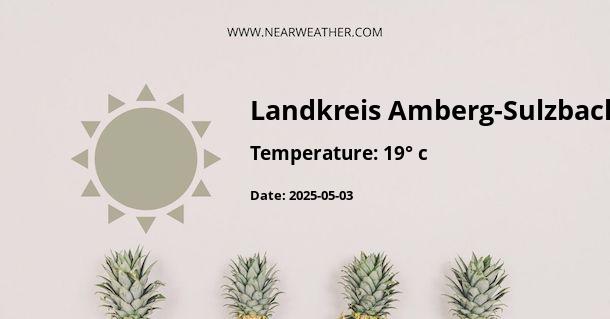The Climate and Weather of Landkreis Amberg-Sulzbach, Germany
Located in the eastern part of the German state of Bavaria, the district of Amberg-Sulzbach (Landkreis Amberg-Sulzbach in German) offers a continental climate with nuances due to its geographical location and topography. Understanding the climate and weather patterns of this district can provide invaluable insights into both the day-to-day life of its inhabitants and the considerations necessary for activities such as agriculture, tourism, and infrastructure development.
General Climate Overview
The climate in Landkreis Amberg-Sulzbach can be classified as a humid continental climate. It is characterized by warm summers and cold winters, with precipitation fairly distributed throughout the year. The district's climate is influenced by its position away from major bodies of water and by its varied topography, including the elevated areas of the Upper Palatinate Forest (Oberpfälzer Wald).
"Landkreis Amberg-Sulzbach exhibits a remarkable climatic diversity due to its topographical influences, with temperature and precipitation variations across the district's range of altitudes."
Temperature Trends
Temperature fluctuations reflect the continental influence, with potential extremes in the summer and winter months. To understand these variations, let's examine the seasonal temperature trends in the area.
- Winter: December through February witnesses the coldest temperatures, averaging between -4 to 4 degrees Celsius (24.8 - 39.2 degrees Fahrenheit). January often sees the lowest temperatures, and snow cover is common, especially in the elevated regions.
- Spring: March through May marks a transition with temperatures warming to averages of about 8 to 15 degrees Celsius (46.4 - 59 degrees Fahrenheit). This season sees a mix of rain and sunshine.
- Summer: June through August is the warmest period, with temperatures ranging between 18 to 24 degrees Celsius (64.4 - 75.2 degrees Fahrenheit). Heat waves can occasionally push temperatures higher, potentially leading to thunderstorms.
- Autumn: September through November experiences cooler temperatures and increasing rainfall. Average temperatures drop from 14 to 6 degrees Celsius (57.2 - 42.8 degrees Fahrenheit) as September transitions into November.
Precipitation Patterns
Landkreis Amberg-Sulzbach sees relatively evenly distributed annual precipitation, with a tendency for rain to peak during the warmer months, partly due to convective rainfall (thunderstorms).
| Month | Precipitation (mm) | Precipitation (inches) | Days with Precipitation |
|---|---|---|---|
| January | 40 | 1.57 | 10 |
| February | 35 | 1.38 | 9 |
| March | 45 | 1.77 | 12 |
| April | 50 | 1.97 | 13 |
| May | 60 | 2.36 | 14 |
| June | 70 | 2.76 | 15 |
| July | 80 | 3.15 | 16 |
| August | 75 | 2.95 | 15 |
| September | 55 | 2.17 | 12 |
| October | 45 | 1.77 | 11 |
| November | 55 | 2.17 | 13 |
| December | 50 | 1.97 | 13 |
Seasonal Variability and Extremes
The region is susceptible to occasional climate extremes, such as heatwaves in summer and cold snaps in the winter. For example, the winter of 2018-2019 witnessed prolonged snowfall causing significant disruptions, and the summer of 2019 saw record-breaking high temperatures for Germany, affecting Landkreis Amberg-Sulzbach as well.
"Extreme weather conditions, though infrequent, pose challenges to the Amberg-Sulzbach district, necessitating preparedness measures by local authorities and residents to mitigate potential impacts."
Wind Patterns and Sunlight Hours
Wind speeds in the district are generally moderate throughout the year, with occasional gusts accompanying storm fronts. The annual average wind speed stays around 10-15 kilometers per hour (6-9 miles per hour). Regarding sunlight, the district receives varying amounts of sunshine throughout the year, with longer days in summer and shorter days in winter due to its northern latitude.
Climate Change Considerations
Climate change poses an increasingly significant impact on regional weather patterns, and Landkreis Amberg-Sulzbach is no exception. Recent trends suggest an increase in extreme weather events, such as storms and heavy rainfall, as well as fluctuations in the traditional seasons with warmer winters and hotter summers. Such shifts necessitate ongoing research and adaptive strategies in urban planning, agriculture, and environmental conservation in the district.
Implications for Agriculture and Tourism
Understanding the climate and weather of Landkreis Amberg-Sulzbach is crucial for regional agriculture, which relies on knowledge of seasonal conditions for crop planning and management. Similarly, the tourism industry benefits from awareness of peak weather conditions for outdoor recreational activities.
"The local economy, particularly in sectors like agriculture and tourism, depends heavily on the predictability of weather patterns and seasonal climate behavior."
Summary and Observations
The climate in Landkreis Amberg-Sulzbach represents a classic continental climate with moderate to heavy precipitation and significant variation between seasons. The realities of climate change call for adjustments and adaptive measures to ensure sustainability and resilience for local industries and inhabitants. Understanding these weather dynamics is essential for the planning and successful operation of various ventures in the district.
Overall, the district experiences a climate that is both challenging and rewarding, presenting opportunities for a variety of outdoor activities throughout the year, but also demanding forethought and adaptability to the forces of nature.
A - Landkreis Amberg-Sulzbach's Latitude is 49.494171 & Longitude is 11.814720.
A - Weather in Landkreis Amberg-Sulzbach is 3° today.
A - Climate Conditions in Landkreis Amberg-Sulzbach shows scattered clouds today.
A - Humidity in Landkreis Amberg-Sulzbach is 69% today.
A - Wind speed in Landkreis Amberg-Sulzbach is 10.4 km/h, flowing at 296° wind direction. today.
